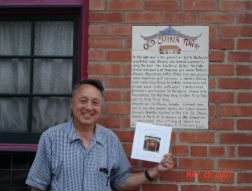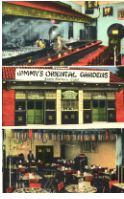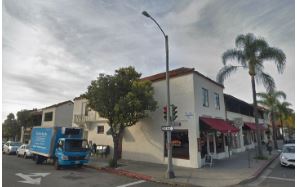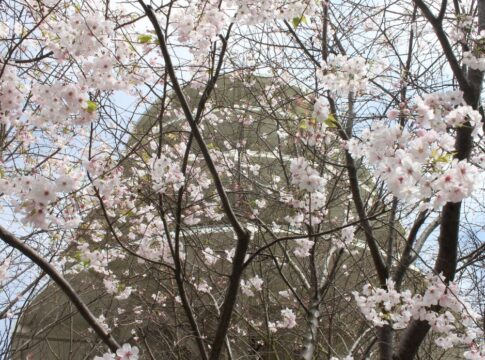By Raymond Douglas Chong (Zhang Weiming), AsAmNews Staff Writer
Across a vast America, dozens of lost Chinatowns dot the American cityscape. These ethnic enclaves have sadly faded in people’s memories . Only archival stories, vintage photos, and unique films remain inside dusty bins.
Old Chinatown at Santa Barbara
In the Old Spanish mission town of Santa Barbara on the California coast, a glazed tile plague marks Santa Barbara Chinatown outside the front of the iconic Jimmy’s Oriental Gardens Restaurant.
According to urban tale, the early Chinese sojourners arrived about 1863. Chinese, mainly from Sye Yup region of Kwangtung, worked as farmers, laborers, servants, laundrymen, fishermen, midst an insular society of bachelors. Around 1865, Ah Lim opened a cookhouse – restaurant, on State Street, to feed the hungry workers. The commerce at Santa Barbara was driven by cattle and sheep ranches, vegetable farms, fruit orchards, and abalone fisheries.

Tommy Yee Chung at landmark plaque in front
of old Jimmy’s Oriental Gardens Restaurant.
In sampans, Chinese were plying the sea near Channel Islands for abalone that was prized for its meat and shell. The Chinese built the roads and railroads including the Santa Ynez Turnpike Road in San Marcos Pass and Southern Pacific Railroad Coast Line. At resort hotels, including the landmark Arlington Hotel, and private homes, they served as houseboys and cooks.
LATEST STORIES
An Old Chinatown gradually emerged among the wooden buildings on 00 block of East Canon Perdido Street, between State Street and Anacapa Street. As they become settled, merchants operated stores, restaurants, and laundries. Old Chinatown was a mix of 2-story wood buildings with storefront businesses and above ground residences. Old Chinatown consisted of a temple, joss house, tong halls, grocery stores, rooming houses, barber shops, and labor contracting offices. Gambling halls and opium den were at backrooms or upper floors, places for the men to escape the tedium of a cruel bachelor society, without women and children.

– Jimmy’s Oriental Garden Restaurant
According to a 1913 directory, Old Chinatown was the lively hub of restaurants, general merchandise stores, groceries, cigars stores, and abalone dealers. Hop Sing Tong and Bing Kong Tong were in their midst. A population of about 200 Chinese, mostly lonely men, lived a barren existence in Old Chinatown.
On June 29, 1925, a strong earthquake struck Santa Barbara with great devastation. Old Chinatown was slightly destroyed. Prominent White property owners greedily demolished the rest of Old Chinatown, to selfishly create a cohesive Spanish Colonial Revival look for downtown.
Hop Sing Tong and Bing Kong Tong harshly ruled the Chinese community. They profitably controlled the illicit businesses of gambling and opium. From the joss house and Masonic temple, next to Lobero Theatre, two Bing Kong Tong hatchet men assassinated Gin Han, the leader of Hip Sing Tong, during the evening of July 1, 1926, in a brief Tong War.
New Chinatown at Santa Barbara

From debris, Elmer Whittaker, realtor and entrepreneur, built a New Chinatown, with funding by three Chinese merchants, in the late 1920’s. Whittaker built a complex of stucco Spanish Colonial Revival style buildings on 100 block of East Canon Perdido Street between Anacapa Street and Santa Barbara Street. The last residents of Old Chinatown moved to this New Chinatown, near El Presidio de Santa Bárbara and adjacent to Nihonmachi – Japantown.
Ella Yee Quan, a Santa Barbara native, recalled the life in New Chinatown. Storefront businesses were on the ground floor, while residences were on the second floor. The first building had 12 units on East Canon Perdido Street and the second building had 8 units on Santa Barbara Street. The streets were dotted with the Hop Sing Tong Association, Bing Kong Tong Association, Chinese language school, Chinese boys club, grocery stores, restaurants, laundry, herbal store, general merchandise stores and cigar stores. With the Great Depression and World War II, the hub of businesses slowly faded away as the Chinese population dwindled.

Jimmy’s Oriental Garden advertisement
In 1947, Whittaker built the last piece of New Chinatown, Jimmy’s Oriental Gardens Restaurant, built for James “Jimmy” Yee Chung. The one-story restaurant had a brick façade, while two-story residence was in back. In accordance to Chinese tradition, Jimmy held a grand opening for the Chinese community of Santa Barbara. It was a memorable gala event. This landmark restaurant was well-known for its Cantonese cuisine, better known as Chop Suey, as well as gigantic egg rolls and powerful drinks like the Mai Tai cocktail. Patrons danced.
Tommy Yee Chung, the second son of Jimmy, who started to work for his father in 1967, assumed management of the Restaurant in 1970, until its finale in summer 2006. Julie Chung, wife, operated the kitchen. Esther and Pearl served the patrons. Sal provided support, and Willie, the bartender, mixed the high-octane drinks at the bar.
Tommy served Chop Suey dishes, with steamed white rice, vegetables, pork, beef, chicken, shrimp, almonds, and black mushrooms. Popular Cantonese-style dishes were pan-fried noodles mixed with pork, beef, chicken, or shrimp, almond chicken, mushroom chicken, tomato beef, and subgum. They also had family-style dinners, as well as “American” dinners, including steak and chicken meals.
Tommy operated Jimmy’s Gardens Restaurant as a venerable comfort station and watering hole for the eclectic community of Santa Barbara, until July 29, 2006.
On Sunday July 30, 2006, a waxing crescent of the summer moon descended into the far west. Santa Barbara Chinatown was lost, forever.
AsAmNews has Asian America in its heart. We’re an all-volunteer effort of dedicated staff and interns. Check out our new Instagram account. Go to our Twitter feed and Facebook page for more content. Please consider interning, joining our staff, or submitting a story.









Great article of life in old and new Chinatown